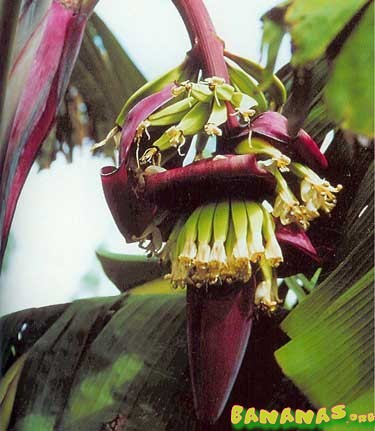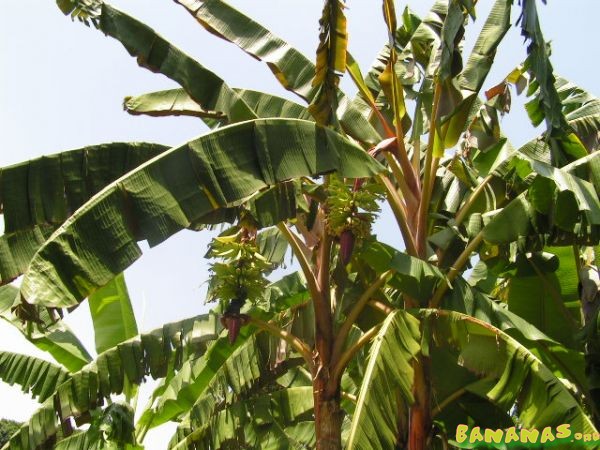Musa Red Iholene
From Bananas Wiki
| Revision as of 14:54, 20 March 2007 (edit) MediaHound (Talk | contribs) (→Members Growing This Banana) ← Previous diff |
Current revision (01:43, 9 March 2024) (edit) Reminosys (Talk | contribs) (Clarified some info and added details) |
||
| Line 1: | Line 1: | ||
| ==Cultivar Name== | ==Cultivar Name== | ||
| + | |||
| + | Musa 'red iholene' | ||
| + | |||
| ===Synonyms=== | ===Synonyms=== | ||
| + | |||
| + | Iholena Lele (?) | ||
| + | |||
| ==Pictures== | ==Pictures== | ||
| Line 7: | Line 13: | ||
| (credit [http://www.bananas.org/member.php?u=658 the flying dutchman]) | (credit [http://www.bananas.org/member.php?u=658 the flying dutchman]) | ||
| + | |||
| + | http://www.bananas.org/gallery/watermark.php?file=2685&size=1&filefix=.jpg | ||
| + | |||
| + | (credit [http://www.bananas.org/member.php?u=5 Gabe15]) | ||
| ==Description== | ==Description== | ||
| - | One of the most ornamental of all banana plants, and this one bears fine-tasting fruit. | + | As with other Iholena cultivars, Red Iholene has leaves that are burgundy to bronze colored on their underside, but stands apart with its signature characteric of a red-pink pseudostem. The spelling "Iholene" likely stems from a transcription error that was perpetuated, given that it is in the Iholena Subgroup. In comparison to other banana varieties, it is of an intermediate height. It is comparable to [[Musa White Iholene|White Iholene]], some of which may be Red Iholene that lost their red pigmentation. |
| - | This hawaiian cultivar has leaves that are burgundy colored on their lower surface to | + | :*The late Bill Lessard wrote on how some of his "Red Iholene" plants would lose pigmentation and become "White Iholene", and how they never seemed to revert back to a red form. However, this may be due to the planting density or light exposure, as anecdotal reports suggest that pigmentation development is related to light intensity. |
| - | match the red-pink pseudostem. Being of a modest height, it is suited to both the landscape | + | |
| - | and greenhouse where it makes a beautiful specimen. The unripe fruit skin starts out pale yellow | + | |
| - | and should not be picked until it is very ripe. This is a close relative of musa 'White Iholene' | + | <strike>Lele means 'to fly' and is one of the comonnest wild bananas of the uplands on all the islands of Hawaii. |
| - | and musa 'Ha'a' wich is the dwarf form of the 'Iholene' group. | + | It has a tall slender, tapering trunk with narrow leaves. The fruit grows in small compact bunches on a long red stem, is angular and tapering and several fruits are generally warped or pressed flat. The skin is thin, and is yellow well before peak ripeness. The flesh is light pink and can be eaten fresh or cooked. |
| + | The leaf is light green(young leaf reddish underneath), petiole light green. The trunk is light green with a yellowish tinge. This banana used to be planted by the altar(lele) in the temples. In 'feeding' ancestral | ||
| + | spirits(aumakua) this banana served as an offering(mohai). In 'love magic' (hana aloha) one ate a lele | ||
| + | banana to make love. | ||
| + | In weaning two Lele bananas were laid in front of the child, if it ate one the desire for the breast | ||
| + | 'flew away', if it did not take one weaning was prosponed. Juice extracted from the root of the sprout | ||
| + | (pohuli) was given to children as medicine for trush(ea). This banana was used in feeding patron sharks | ||
| + | at Kamilo beach, Kau.</strike> (details to be revised/clarified at a later date) | ||
| + | |||
| + | |||
| + | |||
| + | *Genetic Group - Eumusa, AAB, Subgroup Iholena | ||
| + | |||
| + | ===Possible Relatives=== | ||
| + | *[[Musa Iholena Lele|Iholena Lele]] has a red morph that may be identical. Kepler & Rust identified that some Red Iholene may originate from tissue culturing. | ||
| + | *[[Musa Iholena 'ula ula'|Iholena 'Ula'ula]] was a variety introduced to Florida prior to the first written mention of Red Iholene. It's possible that it was renamed (ula=red in Hawai'ian) by rare fruit collectors, and that some Red Iholene are derived from Iholena 'Ula'ula. | ||
| - | *Genetic Group - | ||
| ===Origin=== | ===Origin=== | ||
| Line 26: | Line 50: | ||
| ===Usage=== | ===Usage=== | ||
| + | |||
| + | Multipurpose banana: Often used as a cooking banana, it can be eaten raw if adequately ripened. | ||
| ==Flowering== | ==Flowering== | ||
| Line 36: | Line 62: | ||
| *Mature Height - | *Mature Height - | ||
| + | |||
| + | 12-14 feet | ||
| *Survival Zone - | *Survival Zone - | ||
| + | |||
| + | 8-10 | ||
| *Fruiting Zone - | *Fruiting Zone - | ||
| Line 44: | Line 74: | ||
| *Wind - | *Wind - | ||
| + | |||
| + | Wind tolerant | ||
| *Sun - | *Sun - | ||
| + | |||
| + | Full sun | ||
| *Taste Description - | *Taste Description - | ||
| Line 55: | Line 89: | ||
| ===Known Afflictions=== | ===Known Afflictions=== | ||
| *Pests - | *Pests - | ||
| + | |||
| + | Borers, grasshoppers and root nematodes | ||
| *Susceptible Diseases - | *Susceptible Diseases - | ||
| - | *Resistant Diseases - | + | Panama disease and black sigatoka |
| + | |||
| + | |||
| + | *Resistant Diseases - | ||
| ==Research Notes== | ==Research Notes== | ||
| Line 69: | Line 108: | ||
| <googlemap lat="29.840644" lon="-26.015625"> | <googlemap lat="29.840644" lon="-26.015625"> | ||
| 26.063414912034293, -80.25358263521576, [[User:MediaHound]] | 26.063414912034293, -80.25358263521576, [[User:MediaHound]] | ||
| + | 38.639434, -121.313396, [[User:Microfarmer]] | ||
| + | 38.14559382685236, -121.68171644210815, [[User:harveyc]] | ||
| + | 36.22084858508668, -115.15327870845795, [[User:Chironex]] | ||
| + | 37.739481, -25.668315, [[User:Pedrotvs]] | ||
| </googlemap> | </googlemap> | ||
| Line 76: | Line 119: | ||
| *Sources | *Sources | ||
| + | Kepler, A.K. and Rust, F.G. 2011. The world of bananas in Hawai'i: then and now. Pali-O-Waipi'o press, Hawaii. 586p. https://uhpress.hawaii.edu/title/the-world-of-bananas-in-hawaii-then-and-now/ | ||
| + | Lessard W. O. (1992). The complete book of bananas. W.O. Lessard. | ||
Current revision
Contents |
Cultivar Name
Musa 'red iholene'
Synonyms
Iholena Lele (?)
Pictures

(credit the flying dutchman)

(credit Gabe15)
Description
As with other Iholena cultivars, Red Iholene has leaves that are burgundy to bronze colored on their underside, but stands apart with its signature characteric of a red-pink pseudostem. The spelling "Iholene" likely stems from a transcription error that was perpetuated, given that it is in the Iholena Subgroup. In comparison to other banana varieties, it is of an intermediate height. It is comparable to White Iholene, some of which may be Red Iholene that lost their red pigmentation.
- The late Bill Lessard wrote on how some of his "Red Iholene" plants would lose pigmentation and become "White Iholene", and how they never seemed to revert back to a red form. However, this may be due to the planting density or light exposure, as anecdotal reports suggest that pigmentation development is related to light intensity.
Lele means 'to fly' and is one of the comonnest wild bananas of the uplands on all the islands of Hawaii.
It has a tall slender, tapering trunk with narrow leaves. The fruit grows in small compact bunches on a long red stem, is angular and tapering and several fruits are generally warped or pressed flat. The skin is thin, and is yellow well before peak ripeness. The flesh is light pink and can be eaten fresh or cooked.
The leaf is light green(young leaf reddish underneath), petiole light green. The trunk is light green with a yellowish tinge. This banana used to be planted by the altar(lele) in the temples. In 'feeding' ancestral
spirits(aumakua) this banana served as an offering(mohai). In 'love magic' (hana aloha) one ate a lele
banana to make love.
In weaning two Lele bananas were laid in front of the child, if it ate one the desire for the breast
'flew away', if it did not take one weaning was prosponed. Juice extracted from the root of the sprout
(pohuli) was given to children as medicine for trush(ea). This banana was used in feeding patron sharks
at Kamilo beach, Kau. (details to be revised/clarified at a later date)
- Genetic Group - Eumusa, AAB, Subgroup Iholena
Possible Relatives
- Iholena Lele has a red morph that may be identical. Kepler & Rust identified that some Red Iholene may originate from tissue culturing.
- Iholena 'Ula'ula was a variety introduced to Florida prior to the first written mention of Red Iholene. It's possible that it was renamed (ula=red in Hawai'ian) by rare fruit collectors, and that some Red Iholene are derived from Iholena 'Ula'ula.
Origin
Hawaii
- Date realized in trade -
Usage
Multipurpose banana: Often used as a cooking banana, it can be eaten raw if adequately ripened.
Flowering
- Time To Bloom -
- Time To Harvest -
Cultivation
- Mature Height -
12-14 feet
- Survival Zone -
8-10
- Fruiting Zone -
- Cold Hardiness -
- Wind -
Wind tolerant
- Sun -
Full sun
- Taste Description -
- Personal Notes -
- Growth tips -
Known Afflictions
- Pests -
Borers, grasshoppers and root nematodes
- Susceptible Diseases -
Panama disease and black sigatoka
- Resistant Diseases -
Research Notes
- Links to useful discussion threads in the forum:
- Typical Price Range -
Members Growing This Banana
External
- Links
- (Links to other useful pages on the web that mention this banana. Example: International Banana Society)
- Sources
Kepler, A.K. and Rust, F.G. 2011. The world of bananas in Hawai'i: then and now. Pali-O-Waipi'o press, Hawaii. 586p. https://uhpress.hawaii.edu/title/the-world-of-bananas-in-hawaii-then-and-now/ Lessard W. O. (1992). The complete book of bananas. W.O. Lessard.
